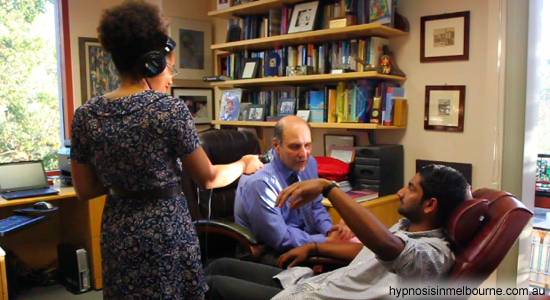The Science of Hypnosis
Hypnosis has been around for centuries. It’s been shown to reduce stress, anxiety and pain. Yet the practice is still struggling for mainstream public acceptance. New research from Stanford University is applying the latest medical imaging tools to figure out the science behind hypnosis, and what makes it work. Youth Radio’s Chantell Williams wanted to know what hypnosis can do for stressed out teens.
First, here’s what hypnosis isn’t: it’s not brainwashing or magic like in the cartoons. Hypnosis is a trance-like state of heightened concentration and it’s more common than you might think. Katie Duchscherer, a psychology major at Stanford University, says, “If you’ve ever really gotten into reading a book or watching a television show and the rest of the world around you has sort-of gone away. Hypnosis is very similar to that.”
Katie uses self hypnosis to control her anxiety in stressful situations. During a test she takes a few deep breaths, goes to a different place mentally and tells herself, “I’m going to use this adrenaline in my system to feel focused for the test.”
Katie learned to hypnotize herself from Dr. David Spiegel, the Associate Chair of Psychiatry and Behavioral Sciences at Stanford. He defines hypnosis as being to consciousness what a telephoto lens is to a camera.
Dr. Spiegel says what Katie’s doing is different from meditation or other self-soothing techniques. She’s easing muscle tension, relaxing non essential parts of her mind, and zooming in on the problem in front of her, leaving only her and the test. Katie has apparently mastered the art hypnosis. But not everyone has the ability to be hypnotized. Dr. Spiegel is using brain scans to research why that is.
A team of researchers, including Dr. Spiegel, used fMRI to show the different “brain signatures” of high and low hypnotizable people. They found a higher connectivity between different brain regions in highly hypnotizable people. (Hoeft et al., Functional Brain Basis of Hypnotizability, 2012)
A team of researchers, including Dr. Spiegel, used fMRI to show the different “brain signatures” of high and low hypnotizable people. They found a higher connectivity between different brain regions in highly hypnotizable people. (Hoeft et al., Functional Brain Basis of Hypnotizability, 2012)
Dr. Spiegel says hypnotizability is partly due to childhood experiences. “Children whose parents are physically abusive tend to be more hypnotizable, and we think that’s because they use their brains in an escape,” Spiegel explains.
Positive childhood experiences also contribute to hypnotizabiltiy. Spiegel says, children who have parents who tell stories and use their imaginations a lot tend to like to keep doing that.
I was a pretty imaginative kid, so I couldn’t help but wonder, could hypnosis work on me? I found a free video by Googling “self hypnosis.” It told me to close my eyes and think about being twice as physically and mentally relaxed. But I couldn’t stop thinking, twice as relaxed? What does it mean to be twice as relaxed?
I really thought hypnosis would work for me. Maybe, with a little training from Dr. Spiegel. He says, “hypnosis is literally the oldest western conception of a psycho-therapy. It’s been around for close to 300 years but we still keep viewing it as weird.”
Weird or not, if I could use hypnosis to help me through my finals, count me in.


